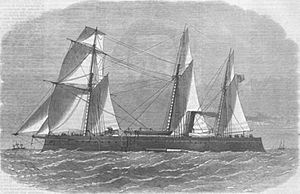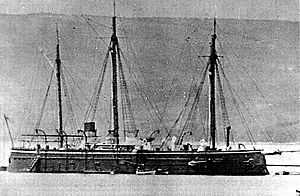HMS Waterwitch (1866) facts for kids

Waterwitch under sail, from the Illustrated London News
|
|
Quick facts for kids History |
|
|---|---|
| Name | HMS Waterwitch |
| Ordered | 29 October 1864 |
| Builder | Thames Ironworks and Shipbuilding Company |
| Laid down | 1864 |
| Launched | 28 June 1866 |
| Commissioned | 1867 |
| Fate | Sold for breaking 26 April 1890 |
| General characteristics | |
| Displacement | 1,280 tons |
| Tons burthen | 777 bm |
| Length | 162 ft (49.4 m) pp |
| Beam | 32 ft 1 in (9.8 m) |
| Draught | 11 ft (3.4 m) |
| Installed power |
|
| Propulsion |
|
| Sail plan | Barquentine rig |
| Speed | 8.9 kn (16.5 km/h) |
| Complement | 80 |
| Armament | |
| Armour | 4+1⁄2 in (11 cm) iron belt and bulkheads with 10 in (25 cm) of teak backing |
HMS Waterwitch was a special kind of warship called an armoured gunboat built for the Royal Navy. What made her truly unique was her engine: she was the first ship to use waterjets for power! Instead of spinning propellers, she sucked in water and shot it out the back to move. Launched in 1866, she was mostly used for testing new ideas, and later sold in 1890.
Contents
How Waterwitch Was Designed
Waterwitch was designed by Rear Admiral George Eliot and his team. She was built as an experimental ship, meaning she was made to test new technologies. She was like a half-sister to two other ships, Vixen and Viper. While her sisters used two propellers, Waterwitch had a special water-pump system.
Her Hull and Armour
Waterwitch was an armoured gunboat, meaning she had strong protection. Her body was made of iron. She had 4.5 inches (about 11 cm) of armour plating. This armour was backed by 10 inches (about 25 cm) of strong teak wood. This thick armour covered about 60 feet (18 metres) of the ship's middle section.
The armoured part of the ship went from below the waterline up to the main deck. The front and back parts of this armoured section were also protected. She also had an armoured belt that ran along the waterline for the entire length of the ship. Waterwitch and her two sister ships were the only armoured gunboats ever built for the Royal Navy. Unlike her sisters, she had a rudder at the front (bow rudder) as well as the usual one at the back (stern rudder).
Her Sails
Even with her special engine, Waterwitch also had sails. She was equipped with a barquentine rig, which is a type of sail setup.
Her Weapons
Waterwitch was armed with two large 7-inch (6.5-ton) guns. These were muzzle-loading rifled guns, meaning they were loaded from the front and had grooves inside the barrel to make the cannonball spin. She also had two smaller 20-pounder guns, which were breech-loading, meaning they were loaded from the back.
Her Unique Engine: Waterjets!
Waterwitch's most interesting feature was her unique propulsion system. It was like a giant, powerful pump. This pump, driven by steam, sucked water from openings in the middle of the ship. Then, it shot the water out in powerful jets from adjustable nozzles. She had two sets of nozzles: one for moving forward and one for going backward.
The steam for the pump came from two large boilers. The main part of the engine was a huge wheel, 14.5 feet (4.4 metres) across, which weighed 8 tons. This wheel was spun by three steam cylinders and produced a lot of power. Mr. M. W. Ruthven, whose father invented this system, believed it would make ships safer and faster. He said that this "hydraulic propeller" could also be used to pump out water if the ship was leaking, making it very safe.
Building Waterwitch
Waterwitch was ordered from the Thames Ironworks and Shipbuilding Company on October 29, 1864. Her construction began that same year. She was launched into the water on June 28, 1866. She officially started her service on June 26, 1867, under the command of Commander Philip Ruffle Sharpe. Her first job was to take part in special trials to test her new technology.
Waterwitchs Time at Sea
In the late 1860s, Waterwitch took part in important tests with her sister ships, Vixen and Viper. These tests happened at Stokes Bay in the Solent. The goal was to compare how well each ship performed.
Waterwitch was very good at turning, even better than her sisters. However, none of these experimental ships were very fast. They could only reach about 9.5 knots (about 17.6 km/h). To compare, another famous warship of the time, Warrior, could go much faster, at 14.5 knots (about 26.9 km/h). In 1867, an important American admiral, David Farragut, even came to inspect Waterwitch.
The armoured gunboats, including Waterwitch, didn't perform as well as hoped in terms of speed. This was partly because of the shape of their hulls. Even though Waterwitch's waterjet system was unique and allowed her to turn very well, it took up a lot of space inside the ship. In the end, the common propeller system was usually preferred over this early form of jetboat.
Waterwitch spent much of her later life as a test ship. She was often docked at Portsmouth, where engineers continued to study her unique propulsion system.
What Happened to Waterwitch?
After her testing days were over, Waterwitch was no longer considered active. She was eventually sold to a company called Castle on April 26, 1890. They took her apart for scrap at Charlton.



